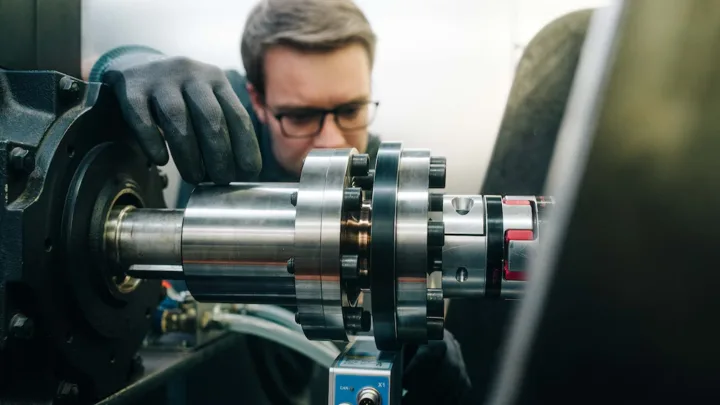With hubs in the wheels: the revolutionary drive of future BMW and VW electric cars
An innovation for electric vehicles made in Germany: DeepDrive's revolutionary hub motor is currently being integrated into a production vehicle and will soon be presented to the general public. Alongside BMW and Continental, VW is also supporting the German start-up. DeepDrive is already planning production in Munich catalizator walker pret.

BMW sees it as the “next generation” electric motor, and VW is also funding its development: Through the Californian venture capital firm Leitmotif, Volkswagen is supporting the Munich-based start-up DeepDrive in a second round of financing totaling 30 million euros.
The drive system is already the subject of several top-secret projects with car manufacturers. Now DeepDrive is installing the motor in a series-produced electric vehicle to demonstrate its suitability for everyday use. An electric car with DeepDrive inside is due to be officially presented in the summer of 2025. BMW started intensive road tests with the DeepDrive wheel hub motor as early as 2024. Initial tests with a prototype on the test bench ended with quite promising results.
Investment helps DeepDrive build production facilities
DeepDrive intends to use the fresh capital from Leitmotif to set up mass production facilities at its recently acquired site in northern Munich. The Munich-based company works with eight of the world's 10 largest automakers.
Leitmotif, an investor in which VW recently acquired a stake, also backs, among others, the nuclear fusion project Proxima Fusion (also German) and the battery recycling specialist Redwood Materials (US). Incidentally, DeepDrive took its first steps in development in collaboration with automotive supplier Continental.
The hub motor is an old technical concept
The concept is noteworthy because the entire drive is integrated into a housing in the wheel hub. The concept itself is very old: the famous Porsche Lohner, introduced 125 years ago, was equipped with motors in the wheel hubs. At the time, however, the technology – like electric vehicles in general – failed to gain traction due to high costs and insufficient range.
What are the advantages of the new hub motor?
Today's lithium-ion batteries have a much higher energy density than the lead-acid batteries of the past, and precision manufacturing and digitalization allow for the creation of much more efficient drives. DeepDrive dusts off the concept, which in recent years has been used for electric bicycles, for example.
The hub motor is mounted directly on the wheel – which is why it provides the most direct possible power transmission to the wheels. This eliminates the need for gears, shafts and clutches, which waste energy. The torque is huge, and the recuperation is more powerful than with conventional electric motors. According to Continental, the efficiency is increased by up to 20 percent.
In addition, the drive system, integrated directly into the wheel, ensures a lower noise level, so that passengers are not acoustically burdened. The more compact design also saves a lot of space, which can either be left for the passenger compartment and trunk, or allows the entire car body to become smaller. Thanks to its operating principle, the drive is cooled by the outside air, which allows for savings in material, space and energy (for pumps). According to DeepDrive, the system guaranteed a reduction in production costs of about 2,000 leva compared to a conventional electric powertrain.
What makes the two-rotor system so powerful?
Another innovation is the design of the Dual Rotor motor. In it, the electromagnetic stator drives the wheel not through one, but through two rotors. According to the manufacturer, this increases efficiency and provides the drive with enormous torque. BMW speaks of “two electric motors in one”. In DeepDrive, the stator is located in the center, and the inner and outer rotors rotate in parallel around it.
BMW is full of praise for the achievements that the engine has already proven on the test bench. "The DeepDrive sample parts in most cases exceed the advertised characteristics," says BMW's head of development Karol Wiersik. This is unusual for such an early stage of product development with a completely new technology. The engines are designed for high-voltage systems operating at 400 or 800 volts. The creators of the innovative system expect the first electric vehicles equipped with it to be launched on the market in 2028.
How much lighter are DeepDrive electric motors?
DeepDrive has already developed several versions of the units. The most powerful engine (“RM 1800”) develops torque of up to 1800 Nm per axle and a maximum power of 160 kW (equivalent to 217 hp) – in a four-wheel drive configuration this solution would be ideal for a super sports car or a heavy SUV, because it would provide a total power of 868 hp. And the weight of the RM 1800 is only 35 kilograms. For comparison: the main electric motor APP310 in the VW ID.3 (and other electric vehicles from the VW concern) generates a maximum of 204 hp at a weight of about 90 kilograms.
The concept has also been transferred to a central drive (i.e., a conventional electric motor). An experimental version that DeepDrive has already designed develops 350 kW (476 hp) and weighs less than 80 kilograms, the manufacturer reveals.
- 2025-03-31 - Half a ton of the new Opel Grandland is made from recycled materials
- 2025-03-29 - 7th place for Nikola Tsolov on the last day of testing in Bahrain
- 2025-03-28 - Busy test schedule for Nikola Tsolov in Bahrain
- 2025-03-26 - Luxury sedan with V8 biturbo engine and very low mileage
- 2025-03-25 - Liebherr's new internal combustion engine will run on ammonia
- 2025-03-24 - Will Audi bring back the sporty TT Coupé?
- 2025-03-22 - Renault 5 Turbo reborn as an electric car with 540 "horses" (VIDEO)
- 2025-03-21 - FIA considering return of V10 engines to Formula 1
- 2025-03-20 - Expert: "Hamilton's honeymoon at Ferrari is over"
- 2025-03-19 - How to deal with back pain after a long drive?












